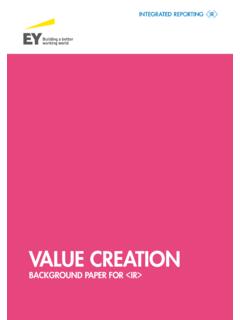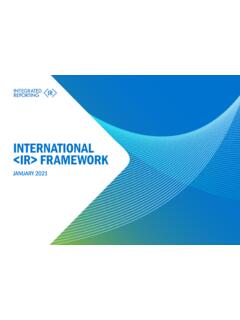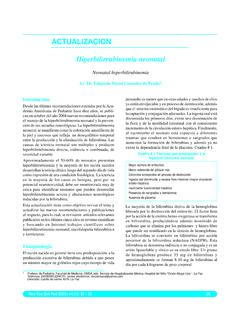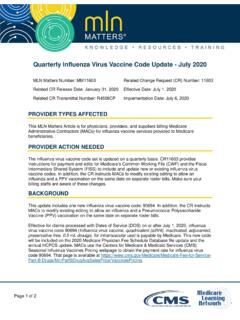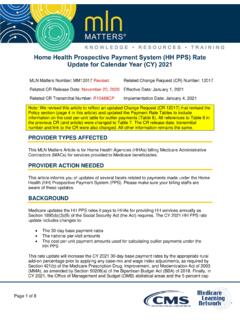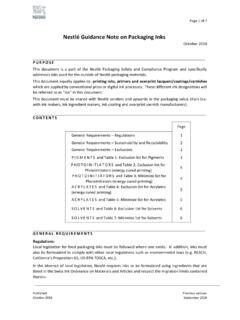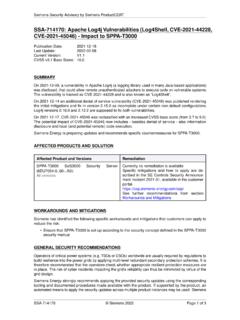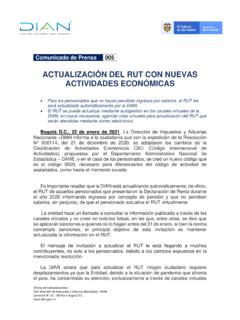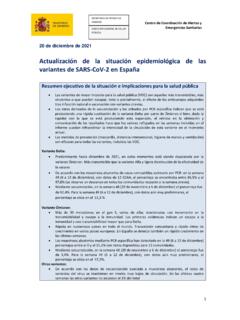Transcription of INTERNATIONAL <IR> FRAMEWORK - Integrated Reporting
1 INTERNATIONAL <IR> FRAMEWORKJANUARY the IIRCThe INTERNATIONAL <IR> FRAMEWORK was developed to meet this need and provide a foundation for the future. Further information about the IIRC can be found on its website , including its: Purpose, mission and vision Structure and membership Governance and funding Procedures INTERNATIONAL <IR> FRAMEWORK (January 2021) supersedes the INTERNATIONAL <IR> FRAMEWORK (December 2013). This latest version applies to Reporting periods commencing 1 January 2022. Earlier application is welcome. Other resources For more on Integrated Reporting and how the <IR> FRAMEWORK can be applied, visit the IIRC s Frequently Asked Questions and <IR> Examples IIRC does not accept responsibility for loss caused to any person who acts, or refrains from acting, in reliance on the material in this publication, whether such loss is caused by negligence or other wise. Copyright January 2021 by the INTERNATIONAL Integrated Repor ting Council ( the IIRC ).
2 All rights reser ved. Permission is granted to make copies of this work, provided that such copies are for personal or educational use and are not sold or disseminated and provided that each copy bears the following credit line: Copyright January 2021 by the INTERNATIONAL Integrated Reporting Council ( the IIRC ). All rights reser ved. Used with permission of the IIRC. Contact the IIRC for permission to reproduce, store, transmit or make other uses of this document. Other wise, prior written permission from the IIRC is required to reproduce, store, transmit or make other uses of this document, except as permitted by law. Contact: The INTERNATIONAL Integrated Reporting Council (IIRC) is a global coalition of regulators, investors, companies, standard setters, the accounting profession, academia and NGOs. Together, this coalition shares the view that communication about value creation, preservation or erosion is the next step in the evolution of corporate Reporting .
3 Integrated Reporting The IIRC s long-term vision is a world in which Integrated thinking is embedded within mainstream business practice in the public and private sectors, facilitated by Integrated Reporting as the corporate Reporting norm. The cycle of Integrated Reporting and thinking, resulting in efficient and productive capital allocation, will act as a force for financial stability and sustainable development. Integrated Reporting aims to: Improve the quality of information available to providers of financial capital to enable a more efficient and productive allocation of capital Promote a more cohesive and efficient approach to corporate Reporting that draws on different repor ting strands and communicates the full range of factors that materially affect the ability of an organization to create value over time Enhance accountability and stewardship for the broad base of capitals (financial, manufactured, intellectual, human, social and relationship, and natural) and promote understanding of their interdependencies Suppor t Integrated thinking, decision-making and actions that focus on the creation of value over the short, medium and long Reporting is consistent with numerous developments in corporate Reporting taking place within national jurisdictions across the world.
4 It is intended that the <IR> FRAMEWORK , which provides principles-based guidance for companies and other organizations wishing to prepare an Integrated repor t, will accelerate these individual initiatives and provide impetus to greater innovation in corporate Reporting globally to unlock the benefits of Integrated Reporting , including the increased efficiency of the Reporting process is anticipated that, over time, Integrated Reporting will become the corporate Reporting norm. No longer will an organization produce numerous, disconnected and static communications. This will be delivered by the process of Integrated thinking and the application of principles such as connectivity of Reporting is part of an evolving corporate Reporting system. This system is enabled by comprehensive frameworks and standards, addressing measurement and disclosure in relation to all capitals, appropriate regulation and effective assurance. Integrated Reporting is consistent with developments in financial and other Reporting , but an Integrated report also differs from other reports and communications in a number of ways.
5 In particular, it focuses on the ability of an organization to create value in the short, medium and long term, and in so doing it: Has a combined emphasis on conciseness, strategic focus and future orientation, the connectivity of information and the capitals and their interdependencies Emphasizes the importance of Integrated thinking within the thinking is the active consideration by an organization of the relationships between its various operating and functional units and the capitals that the organization uses or affects. Integrated thinking leads to Integrated decision-making and actions that consider the creation, preservation or erosion of value over the short, medium and long term. Integrated thinking takes into account the connectivity and interdependencies between the range of factors that affect an organization s ability to create value over time, including: The capitals that the organization uses or affects, and the critical interdependencies, including trade-offs, between them The capacity of the organization to respond to key stakeholders legitimate needs and interests How the organization tailors its business model and strategy to respond to its external environment and the risks and opportunities it faces The organization s activities, performance (financial and other) and outcomes in terms of the capitals past, present and more that Integrated thinking is embedded into an organization s activities, the more naturally will the connectivity of information flow into management Reporting , analysis and decision-making.
6 It also leads to better integration of the information systems that support internal and external Reporting and communication, including preparation of the Integrated report. SUMMARY 5 PART 1 INTRODUCTION 91. Using the <IR> FRAMEWORK 10 A Integrated report defined .. 10 B Objective of the <IR> FRAMEWORK .. 10 C Purpose and users of an Integrated report.. 11 D A principles-based approach .. 11 E Form of report and relationship with other information..12 F Application of the <IR> FRAMEWORK .. 13 G Responsibility for an Integrated report .. 142. Fundamental Concepts 15 A Introduction .. 15 B Value creation for the organization and for others.. 16 C The capitals .. 18 D Process through which value is created, preserved or eroded .. 21 PART 2 THE Integrated REPORT 243. Guiding Principles 25 A Strategic focus and future orientation.. 25 B Connectivity of information.
7 26 C Stakeholder relationships.. 28 D Materiality.. 29 E Conciseness .. 33 F Reliability and completeness.. 34 G Consistency and comparability.. 364. Content Elements 38 A Organizational overview and external environment .. 39 B Governance.. 40 C Business model .. 41 D Risks and opportunities.. 44 E Strategy and resource allocation.. 44 F Performance .. 45 G Outlook .. 46 H Basis of preparation and presentation .. 475. General Reporting Guidance 49 GLOSSARY 53 APPENDIX SUMMARY OF REQUIREMENTS SUMMARYI ntegrated Reporting promotes a more cohesive and efficient approach to corporate Reporting and aims to improve the quality of information available to providers of financial capital to enable a more efficient and productive allocation of capital. The IIRC s long-term vision is a world in which Integrated thinking is embedded within mainstream business practice in the public and private sectors, facilitated by Integrated Reporting as the corporate Reporting norm.
8 An Integrated Report The primary purpose of an Integrated report is to explain to providers of financial capital how an organization creates, preserves or erodes value over time. An Integrated report benefits all stakeholders interested in an organization s ability to create value over time, including employees, customers, suppliers, business partners, local communities, legislators, regulators and policy-makers. The <IR> FRAMEWORK takes a principles-based approach. The intent is to strike an appropriate balance between flexibility and prescription that recognizes the wide variation in individual circumstances of different organizations while enabling a sufficient degree of comparability across organizations to meet relevant information needs. It does not prescribe specific key performance indicators, measurement methods, or the disclosure of individual matters, but does include a small number of requirements that are to be applied before an Integrated report can be said to be in accordance with the <IR> Integrated report may be prepared in response to existing compliance requirements, and may be either a standalone report or be included as a distinguishable, prominent and accessible part of another report or communication.
9 It should include a statement by those charged with governance accepting responsibility for the Concepts An Integrated report aims to provide insight about the resources and relationships used and affected by an organization these are collectively referred to as the capitals in the <IR> FRAMEWORK . It also seeks to explain how the organization interacts with the external environment and the capitals to create, preserve or erode value over the short, medium and long capitals are stocks of value that are increased, decreased or transformed through the activities and outputs of the organization. They are categorized in the <IR> FRAMEWORK as financial, manufactured, intellectual, human, social and relationship, and natural capital, although organizations preparing an Integrated report are not required to adopt this categorization or to structure their report along the lines of the capitals. The ability of an organization to create value for itself enables financial returns to the providers of financial capital.
10 This is interrelated with the value the organization creates for stakeholders and society at large through a wide range of activities, interactions and relationships. When these are material to the organization s ability to create value for itself, they are included in the Integrated <IR> FRAMEWORK The purpose of the <IR> FRAMEWORK is to establish Guiding Principles and Content Elements that govern the overall content of an Integrated report, and to explain the fundamental concepts that underpin them. The <IR> FRAMEWORK : Identifies information to be included in an Integrated report for use in assessing the organization s ability to create value; it does not set benchmarks for such things as the quality of an organization s strategy or the level of its performance Is written primarily in the context of private sector, for-profit companies of any size but it can also be applied, adapted as necessary, by public sector and not-for-profit SUMMARYS even Guiding Principles underpin the preparation and presentation of an Integrated report, informing the content of the report and how information is presented: Strategic focus and future orientation.


